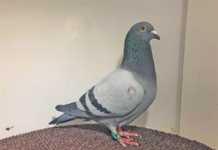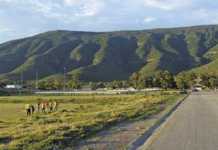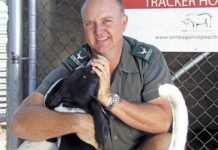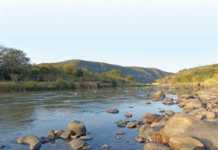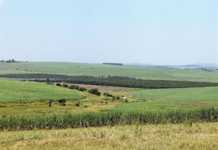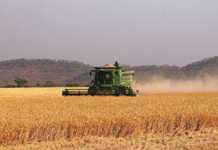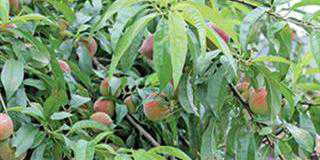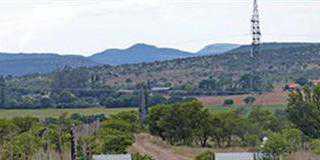“I was on a long flight,” he writes, “when it occurred to me with a certain uncomfortable forcefulness that I didn’t know the first thing about the only planet I was ever going to live on.”
One of the book’s chapters is titled, simply, ‘Bang!’. It’s all about meteors, about the havoc they’ve wreaked in the past, and the danger to life they’ll always pose. By imagining what the dinosaur meteor (Chicxulub, Mexico, 65 million BC) would do if it struck today, Bryson makes his point very forcefully:
“Its approach would be eerily silent since it would be moving far beyond the speed of sound. Within minutes… the whole of the mid-west would be flattened or on fire, and nearly every living thing would be dead. Beyond 1 500km the devastation from the blast would gradually diminish. But that’s just the initial shock wave…”
The Chicxulub space rock was approximately 10km in diameter. It made a crater 180km across and is generally believed to have brought an end to the dinosaur age. By comparison, the bolide (exploding meteor), which struck near present day Vredefort 2 billion years ago, was about the size of Table Mountain and caused a crater almost twice as far across as that at Chixculub.
Bang!
Having read all of this, and in spite of the fact that the impact area is referred to as the Vredefort Dome, I arrived in the area around Parys in the northern Free State expecting to find a hole in the ground. There is no hole, nor anything dome-like either – 2 000 million years of erosion have seen to that. Oceans have since washed over and receded, creating a new landscape with their sediment.
Of course the local municipality that serves local towns like Parys and Venterskroon have done nothing to ‘publicise’ this ‘featurelessness’ because misconceptions bring a valuable trickle of money to the high streets. In fact, very few people one might button-hole on those streets is likely to know anything at all about the area’s geology. And the town information centres are little better.
On a bench inside the Venterskroon tourism bureau someone’s laid out a display of rocks with challenging names like ‘pseudotachylite’. However, there was no layman’s explanation to help ignoramuses like me understand the elusive blast. As for faintly interested employees – forget it, I might as well have asked the quartz.
In the information centre at nearby Parys it was the same. A bespectacled woman spun her fingers rather vaguely over the northern part of a complimentary map and said, “The Vredefort Dome Conservancy is in this area”, before insisting on a visit to O’s restaurant, “which featured on Top Billing not so long ago.”
But my most pressing need, in fact, was a place to pitch my tent. On hearing this the bespectacled lady’s eyes lit up with something like maternal concern, and she let out a long and discouraging “ooh jiss”, and finally said there was only one place: Mimosa Park Caravan Park, but it was likely to be full.
“We’re full,” said Jurie, the caretaker at Mimosa Park, though the large stretch of river frontage before me looked desolate. I strolled down to the river’s edge and stared peevishly at a churning rapid, and I must have cut a figure of considerable dejection because Jurie walked over and said, “You know, I might just be able to find you something.”
This led to a conversation about his life, about how he had spent most of it on a pineapple farm near East London, where the family had kept a pet white lion, and how it had all been taken away in 2010 after the EU put a ban on fruit from the area. A consignment of pineapples was found to have been contaminated by dodgy Chinese fertiliser.
At one point in Jurie’s reminiscences we were interrupted by a silver VW DTi with GP plates. From his leather seat, with low dance music shaking the console, a preppy young man said, “Boet, I’m looking for a place to say, please man, Boet.”
“We’re full,” said Jurie. “sorry Boet.” As the yuppie sped away, Jurie confided that, “we don’t like such people staying in our campsite.”
This was not to be my last experience of xenophobia Parys-style. At sunset, on the deck of the Old Ferryhouse Cocktail Bar overlooking a picturesque section of the Vaal,
a pretty waitress in tiny black shorts warned, “If you’re going to eat in town, don’t even think of going to Heinie’s Pub, because you will probably be beaten up.”
A table of friendly young girls nodded vigorous agreement: “They’ll stick you with a knife.” At AB’s Diner, at the head of the town, it was likely to be a pipe to the head.
They were all in the business of pampering, these girls: a hairdresser, a beautician, a masseuse – clear signs of the town’s continuing economic drift from agriculture to tourism. They introduced me to ‘melktertjies’ and ‘De la Reytjies’ – delicious shooters endemic to the region. Not a smidgen, however, could they tell me about meteors.
I returned to the campsite wondering about the widespread local ignorance of an ancient event to which the town owes much of its marketability. I fell asleep a drunk and ignorant man, lulled by freight trucks rumbling on the Potchefstroom Bridge.
Shortly after 8am the next morning I was sitting in Graeme Addison’s ‘strategy and conferencing’ centre at Otter’s Haunt, his lodge on the west bank of the Vaal River. I was trying not to breathe De la Reytjie fumes over an octogenarian called Thelma, who had dragged her businessman son out of Johannesburg to be there before breakfast.
Acting on a tip from a fellow camper, I’d called Addison out of sheer frustration at 7am, and since Thelma and her son were already paying, he kindly invited me to tag along for a three-hour ‘Dome Walk and Talk’. The talk, crammed full of geological tongue-twisters, preceded the walk, and you’ll find it summarised at www.vdome.co.za.
I will mention one tidbit, though, because it rarely crops up in the discourse on the Vredefort Dome. It has to do with the well-known river at the bottom of Addison’s garden, which is partially clotted with water hyacinth this year. When the tremendous meteor struck, it caused micro cracks to form in the bedrock below, which the Vaal, after working its way patiently through sediment overlaid over millions of years by the Witwatersrand Sea, has now come to exploit. That’s the reason you find myriad rock islands along this section of the Vaal.
You would think this fact makes the Vaal unquestionably part and parcel of the conservancy area (it was declared a UN World Heritage Site in 2004), but the river wasn’t recognised by the powers who conveyed World Heritage status on the region – an oversight which makes the river-loving Addison just plain mad.
Nor is this the only conservation anomaly. On the walking part of the tour, on our way to a disused quarry, where it’s possible to view cross-sections of the rock types, features Addison calls ’the fingerprints of the blast’, we had to skirt a huge trench filled with garbage from a local hotel. And across the valley we spied a functioning quarry, the machinery stilled only because it was Sunday. Clearly the status of ‘World Heritage Site’ is only what the locals make of it, and their will to preserve the environment in the area of the Vredefort Dome appears to be somewhat lacking.
If the conservancy area is ever to fulfil its potential as a tourism and education site, we’ll have people like Addison to thank. He’s taken the time to get know the area he loves and, as a result, digressions tended to be the rule on Dome tour. One minute he would be pointing out the Bankrotbossie (so called because its presence apparently indicates the soil has lost its goodness and therefore portends financial ruin), the next he would be pointing out a kink in the river at which the first Voortrekker party crossed into the Transvaal, only to be repulsed by Mzilikazi’s impis.
Further along, from a spine of quartzite, it seemed suddenly that the nearby hills made a very crater-like curve, but Addison explained that this was merely a ‘collar’ of rock thrown up by the impact, the sort of lip you’d get on the far side of a golf ball tossed into mud.
The rings of the initial craters were out of sight, altogether too distant and too eroded. The first goes through the Grasmere toll plaza, more than 50km away. An outer ring runs through Klerksdorp and Welkom and it may even be that the largest ripple once reached as far as present-day Harrismith. “You can therefore understand,” said Addison, “why we’re having trouble capitalising on the phenomenon.”
Another sticky problem for the Vredefort Dome’s publicists is the persistence of the scientific debate about the real cause of it all. To begin with it was thought the Vredefort Dome must have had volcanic origins, but by 1995 everyone had pretty much agreed it was the fault of an asteroid astrobleme (meteor crater).
Now a small group of earth scientists from Kiel University in Germany are making trouble again, by arguing that the Dome resulted from an eruption out of the earth of vast quantities of gases – a belch so big it might, by releasing more oxygen into the atmosphere, have enabled the growth of more complex life forms then were around before.
Our little group spent two hours longer with Addison than the mother and son team had paid for. The trouble with this walk and talk, he explained, “is that it just keeps growing and growing as I learn new things.” He’s been trying to spin it all into a book (his eighth), which will entwine the development of humanity with the ecological and geographical evolution of the area, all hung on the hook of the world’s oldest meteor strike.
“We journalists,” he confided, “are the only ones who can write a story like this, because we simply don’t know enough about anything to get snagged.” Bill Bryson, also a former journalist, would no doubt agree.

